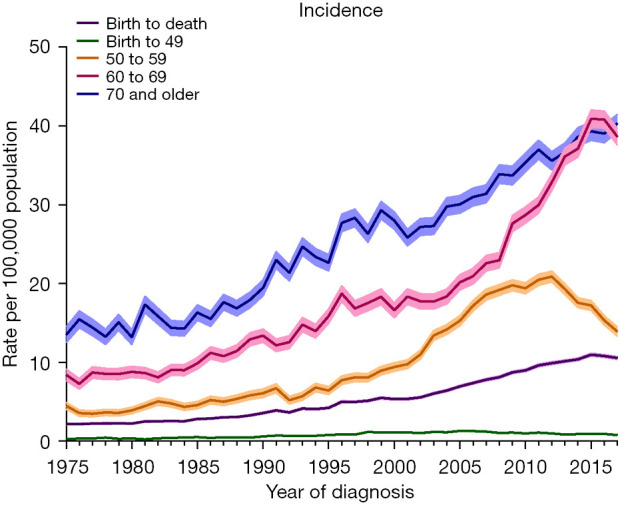
Click to Enlarge: The liver cancer incidence trends of different age groups from 1975 to 2017. Source: Journal of Gastrointestinal Oncology
BETHESDA, MD — The incidence and mortality trends of liver and intrahepatic bile duct cancer in the United States had a dramatic increase from 1975 to 2017, according to data from the National Cancer Institute’s Surveillance, Epidemiology, and End Results (SEER) database.
A report in the Journal of Gastrointestinal Oncology reported that the incidence of hepatocellular carcinoma (HCC) and intrahepatic cholangiocarcinoma (ICC) increased from 2.641/100,000 person-years in 1975 to 8.657/100,000 person-years in 2017. At the same time, the mortality rate shot up from 2.808/100,000 person-years in 1975 to 6.648/100,000 person-years.1
The increase in incidence and mortality rates of males, non-Hispanic Blacks and older individuals was even more rapid, according to the report.
Chinese researchers extracted information on age, gender, race, metastasis, tumor site and tumor grade of patients from the SEER database. They applied codes C22.0 and C22.1 of the International Classification of Disease for Oncology to identify patients with hepatocellular carcinoma (HCC) and/or intrahepatic cholangiocarcinoma (ICC), calculating age-specified incidence, age-standardized incidence and mortality, 5-year relative survival, race-specific accumulative incidence and mortality, and geographic-specific accumulative mortality.
“The overall incidence increased significantly from 2.641/100,000 person-years in 1975 to 8.657/100,000 person-years in 2017 [average annual percent change (AAPC) =3.42, 95% confidence interval (CI): 3.28-3.62, P<0.001],” study authors noted. “The steepest incidence rate increase was observed in the 60-69-year-old age group (AAPC =4.40, 95% CI: 4.10-4.70, P<0.001). Males exhibited a more rapid increase in cancer incidence, from 3.928/100,000 to 13.128/100,000 person-years (AAPC =3.41, 95% CI: 3.21-3.61, P<0.001), than females [from 1.642/100,000 to 4.783/100,000 person-years (AAPC =3.03, 95% CI: 2.91-3.21, P=0.001)].”
In fact, they said the overall mortality rate increased from 2.808/100,000 person-years in 1975 to 6.648/100,000 person-years in 2017 (AAPC =2.41, 95% CI: 2.29-2.51, P<0.001). The highest mortality rate was observed in Hawaii (6.996/100,000 person-years).
Researchers called for “comprehensive policy and control measures should be implemented to reduce the burden of disease, particularly through health monitoring and intervention for high-risk groups.”
Liver cancer was the third most common cause of cancer mortality globally in 2020, making up 8.3% of all cancer deaths. While the principal histologic type of liver cancer is hepatocellular carcinoma (HCC), accounting for up to 90% of primary liver tumors, the second most common type is intrahepatic cholangiocarcinoma (ICC), which involves malignant cells arising from the epithelial cells of the intrahepatic bile duct.
In the United States, the projected incidence of liver and intrahepatic bile duct cancer in 2021 was 42,230 cases, with an estimated 30,230 deaths. Historically, the highest incidence has been in Asia, but the incidence trend in the U.S. is increasing, the authors pointed out.
Another study noted the increase in combined hepatocellular-cholangiocarcinoma (HCC-CC), a primary liver malignancy that is composed of two major liver cancers: hepatocellular carcinoma (HCC) from hepatocytes and cholangiocarcinoma (CC) from bile duct epithelial cells. “This uncommon type of liver cancer has gradually drawn attention as it has become more frequently reported, with the incidence increasing to 14.2% in specific groups,” according to the article in The Oncologist.2
- Yao Z, Dai C, Yang J, Xu M, Meng H, Hu X, Lin N. Time-trends in liver cancer incidence and mortality rates in the U.S. from 1975 to 2017: a study based on the Surveillance, Epidemiology, and End Results database. J Gastrointest Oncol. 2023 Feb 28;14(1):312-324. doi: 10.21037/jgo-23-25. Epub 2023 Feb 23. PMID: 36915450; PMCID: PMC10007921.
- Chen PD, Chen LJ, Chang YJ, Chang YJ. Long-Term Survival of Combined Hepatocellular-Cholangiocarcinoma: A Nationwide Study. Oncologist. 2021 Oct;26(10):e1774-e1785. doi: 10.1002/onco.13893. Epub 2021 Jul 19. PMID: 34213048; PMCID: PMC8488786.

